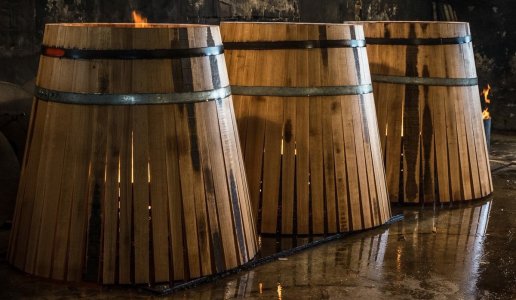Why use barriques?

The world’s greatest wines mature in barriques but in Italy these small barrels are being demonized “in principle” rather than for merit.
As many of you know, barriques are small, 225-liter barrels made from oak (usually French from the forests of Massif Central or Vosgi). The wood staves used are curved by “toasting” them with fire rather than with steam as is done for the bigger barrels, with few exceptions. These staves are thinner than those used for other barrels and are almost always made using an axe rather than by sawing. This results in small imperfections that allow a very slight contact between the wine and the air, which polymerizes the polyphenols making the wine more stable in regard to color, more resistant to oxidation and softer to the palate. Plus, the alcohol in the various wines takes from the wood lignins, creating flavors and aromas that make the wine’s organoleptic properties more complex.
This, more or less, is why small barrels or casks are used.
There are over a thousand variations with much depending on the type of grapes used, the wine’s polyhenolic content and extracts and the acidity, all factors that interact and create very different situations. For example, one thing is to use barriques for red wines, which mature in them after undergoing malolactic fermentation, and another is to use them for white wines, which ferment in wood and do more than only malolactic fermentation. In the second case, the wood gives less to the wine because the space is more reductive because the solid parts of the must literally plug the pores of the wood limiting the extraction of substances foreign to the grape.
Put like this everything seems pure and simple. The French refer to maturing in barriques as “elevation” to underscore the positive aspects. All the great wine from Burgundy, Bordeaux and most of the best from the New World are “elevated” in small casks. Barriques need to be changed frequently, it is better not to use them more than three or four times, to allow the new wood to interact with the wine without the risk of creating conditions, for example, favorable to the formation of brettanomyces, horrible funghi that create unpleasant odors.
Despite all this, for years now there has been a demonization of barriques, especially in Italy, despite the fact that they are a tool in the winery that can be used for better or worse. For better if the wines are those that benefit from interacting contact with new wood, because they have character and significant extracts. For worse if the wines are excessively contaminated by the wood and become “lumberyard wines”, as they were defined years ago by journalist Davide Paolini, in an attempt to mimic the style of prestigious and expensive wines without having the necessary attributes.
There exist precise analytic parameters to determine whether a wine is suited to mature in barriques and these are easy to understand for those with even a minimum knowledge of winemaking. Varieties of grapes like Cabernet, Merlot and Chardonnay mature very well in barriques as do Sagrantino and certain Aglianico wines.
Demonizing barriques, for me, is like demonizing the use of a cast-iron pan or terracotta pot. If the ragu sauce burns it is not the fault of the vessel used, it is perhaps the fault of too high a heat or a distraction on the part of the cook.

 Italiano
Italiano







